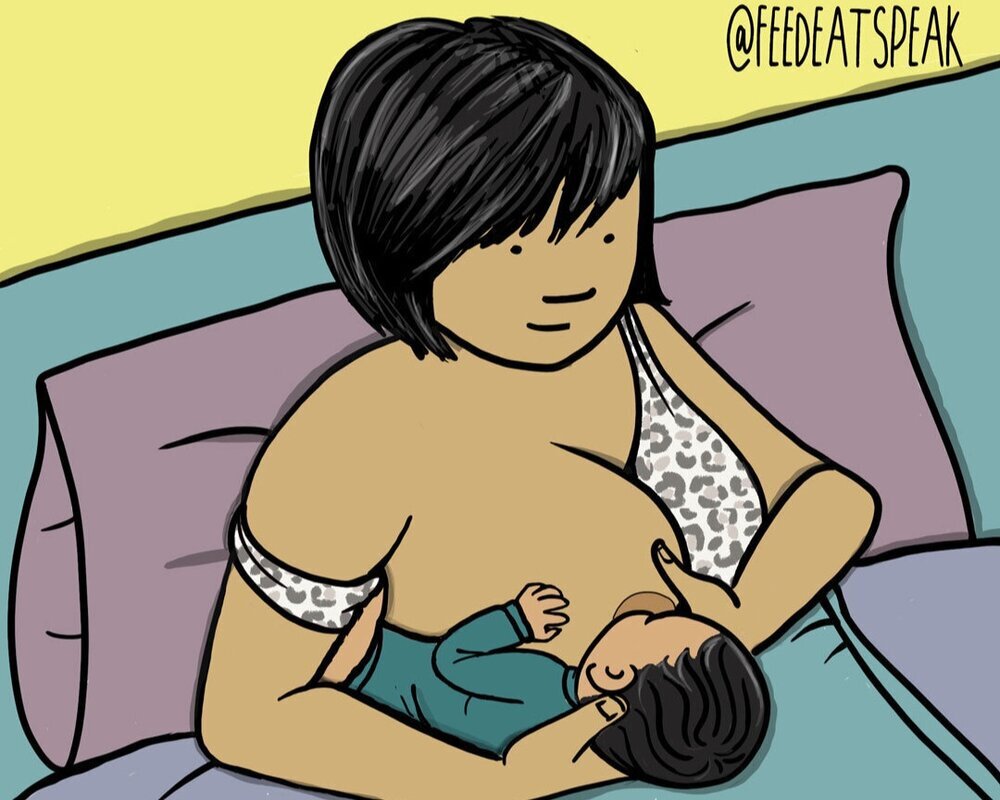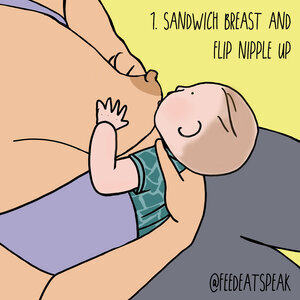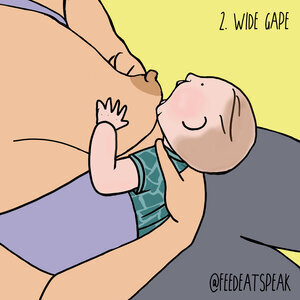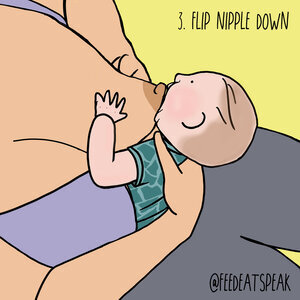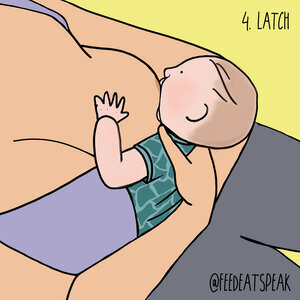Breastfeeding with large breasts
Written by Cordelia Uys, NCT breastfeeding counsellor
It is often assumed that women with larger breasts will produce more milk and that having large breasts is therefore an advantage when you’re breastfeeding. In fact, there’s no correlation between the size of a woman’s breasts and her milk production. Women with larger breasts have more fatty tissue, not more glandular tissue, and the latter is where milk is produced. Of course, women with large breasts can produce plenty of milk; that was certainly my experience with my three sons. I was a bra size 34 H and had a very generous milk supply.
The drawback of having bigger breasts is that it can make latching your baby significantly more challenging. For example, in the commonly used cross-cradle hold, even if tucked closely under your other breast, your newborn baby might not be able to stretch far enough across your body to reach the breast they’re going to feed from. And even if they can reach, it can be difficult to get a good view of what you’re doing.
The laid-back position, in which your baby lies vertically on top of you, can be tricky as they’re likely to sink into the gap between your abdomen and your breast. In some cases, placing a rolled-up flannel or muslin under your breast can fill that gap and allow the baby to latch comfortably.
These are the positions that tend to work best for mums with bigger breasts, especially in the early days:
The rugby hold:
In this position, the baby is tucked under your arm, like a rugby ball, with their feet behind your body. Make sure the arm supporting your baby is well-supported by a cushion or pillow (or two). This position makes it much easier for you and your baby to be in close contact, and for you to see what you’re doing when working on achieving an asymmetric latch. Before latching your baby, place a small cushion behind you, so that it comes up to the small of your back, and then place your baby’s feet on top of the cushion. Once your baby has latched, drop another, bigger cushion behind you. This should allow you to lean back without squashing your baby’s feet.
Side-lying:
This position is an absolute lifesaver as it allows you to breastfeed your baby and rest at the same time. Since the breast you’re feeding from will be lying flat on the mattress, latching tends to be easier. Some bigger-breasted women can even lean forward a little and feed their baby from their other breast. Make sure to put a pillow between your legs, as this will prevent backache. A roll-up baby blanket placed along your baby’s back (but with their head free to tilt back) will help to keep them in place.
Other helpful tips:
A breastfeeding pillow: this can be really helpful if you’re using the rugby or cross cradle hold and find that your baby struggles to stay latched because the weight of your breast pulls it out of their mouth. Do make sure that the pillow doesn’t lift your baby too high, and that you can still tuck them very close to you, with their arms on either side of your breast.
The sandwich hold: shaping your breast while latching your baby can help to hold your breast in place while you achieve an asymmetric latch. Your fingers need to be well back from your areola and parallel to your baby’s mouth. Let your baby do a few sucks to create a seal before removing your hand.
Blocked nose: whatever position you use, if you find your baby’s nose is buried into your breast, all you need to do is pull their bum into your body, and their nose will pivot away.
Nursing bras: A comfortable, supportive and properly fitted bra, that doesn’t put pressure anywhere, is essential for all breastfeeding mothers, and even more so for those with larger breasts. It’s recommended to avoid using an underwired nursing bra for the first 6 weeks, as mothers are particularly vulnerable to getting blocked ducts while their milk supply is being established. Molke make soft bras for large breasted women and are highly recommended by breastfeeding mothers due to the ease of access to the breast. Underwired bras are usually fine after that, as long as they’re 100% comfortable. There are lots of milk ducts on the underside of your breasts, so you don’t want anything constricting that area. If you can’t find a well fitting nursing bra you can convert one of your own bras using a nursing bra conversion kit.
A breast ‘sling’: if you have particularly large breasts, and especially if your nipples point downwards, it can be extremely difficult to see what you’re doing, and to fit your baby close enough to your body, when latching them. Creating a sling out of a long cotton scarf, tying it round your neck and then under your breast, so that the breast is lifted, can be very helpful. This doesn’t tend to be necessary past the newborn stage.
Breastfeeding in public: feeding discreetly with large breasts can be tricky. I remember feeling very envious of my smaller-busted friends who could effortlessly latch their babies without needing a hand to support their breast, especially since the baby then completely covered any bare breast.
Discovering the ‘one up, one down’ method was a revelation. This involves wearing a long, stretchy vest under a looser outer top. The floatier and looser the outer top, the better. You get your baby in position, unclip your bra, pull down the part of the vest covering your breast, lift the outer top and quickly latch your baby. This means all the fiddly unclipping of your bra and manoeuvring of your baby is done under the outer top, and minimal time is spent with your breast on display. The stretchy vest covers not only the breast you’re not feeding from, but also your stomach, which is a part of our body most of us would rather not have exposed.
The good news: as your baby gets older and larger, breastfeeding with larger breasts tends to get much easier.
Cordelia Uys is an NCT breastfeeding counsellor. She facilitates antenatal breastfeeding classes, introducing solids workshops and parenting classes. She also runs a private breastfeeding drop in with a team of IBCLC’s and two cranial osteopaths. Cordelia is also the breastfeeding expert for a new mothers’ wellbeing App Biamother. She is mother to three grown up boys, all of whom were breastfed.


